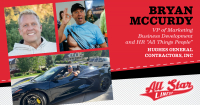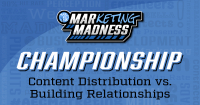Guidance for Marketing Coordinators
Social media is the fingers to the marketing arm, designed to grasp and elevate while relying primarily upon the goals the marketing team has established and the content they are already generating. As a result, the method to its madness lies in bringing everything peripheral back to the center. Social media marketing captures and maintains interest from future, current, and past clients; establishes rapport with your employees; and disseminates important knowledge to a wide (and ideally growing) audience. It is not just a one-method, one-result marketing outlet.
As marketing coordinators, you are focused on drawing attention to your firm’s successful projects. This includes praise, good visuals, and savvy tagging. But projects are not the only content to elevate and extend. You have articles, promotions, get-to-know-yous, webinars, events, community giving, and more. Whatever your firm does, you can find an opportunity to display it. Successful marketing is engaging and authentic—if it is not, potential clients will gloss right over it.
Know Your Platforms
Every social media platform is different, and optimizing each social media post to those platforms is ideal. It is time-consuming to consider all angles, however, so consider your time, budget, and priorities to figure out what is best. In the meantime, familiarize yourself with each platform’s nuances:
Facebook: Two-thirds of Facebook users report visiting a local business Facebook Page at least once a week, so your image there is more important than you might realize. Familiarize yourself with the marketing variety that Facebook offers, which include:
- Text posts: On Facebook, these are ideal for sparking conversation. Ask questions, call for feedback, and try to garner engagement. Alternatively, use these to disseminate important information. Be aware, though, that these posts are not eye-catching or favored by the algorithm.
- Photo posts: These either rely on your eye for visual design or truly eye-catching photography. Coordinate with your firm’s photographers for the latter and truly lean into the impressive details of each project.
- Video posts: Where photo posts have higher engagement than text posts, videos have the highest engagement. Videos play automatically on the news feed—grab your viewers in the first few seconds so that they do not scroll away!
- Live video posts: These are rare to see, but invaluable. If you have an engaged following, you can use these for Q&As, behind-the-scenes tours, product demos, and similar engagements.
- Link posts: This is also known as cross-posting. When posting a link, make absolutely sure your link preview is compelling—from the image to the title. Smart users do not just click on any link.
- Stories: These dwell at the top of everyone’s news feed. You do not have to fight the algorithm up there, and that is invaluable!
Instagram: This platform is as image-focused as you can get, and it’s also the one that relies most heavily on aesthetics. It is critical to consider consistency across posts. Check these facets going in:
- Does the bio make an impact? Consider all the details.
- Your name—30 characters, included in search
- Your username/handle—30 characters, included in search
- Your website—a clickable URL, changeable
- Category—does not use up bio characters, helps users know who you are
- Contact info—tells people where to find you
- Call-to-action buttons—leads to interactions directly from your profile page
- Is the profile picture high quality?
- Are the photos and videos used sharp, well-lit, well-composed, and in focus?
- Are the design features of all posts consistent across color, formatting, and placement?
- Is there a visible and compelling aesthetic across all posts?
- Are the individual captions for each post ideal?
- Organic posts should be between 138–150 characters
- Instagram ads should be 125 characters maximum
- How about the hashtags?
- Though you can use up to 30, ideally you use between 5–9
- They should be relevant and specific to your niche
- Are the stories interesting? The best stories should
- Tell a story
- Convey their message within the first 3 seconds
- Give viewers valuable information or link to useful resources
- Use swiping and tell followers why they should swipe
- Are consistent with brand identity
LinkedIn: Surprisingly, long-form posts perform well on this network. Posts with 1900–2000 words perform best in views and engagement, which means this is your platform for informative, detailed posts and calls to action. Like Facebook, there are a plethora of different ways to advertise, market, and engage users. Familiarize yourself with those options and keep in mind that this is a network that relies on ethos. Users should immediately be able to tell that your firm is an expert. Do not hesitate to be knowledgeable and professional here. Make users stay with information and knowledge that interests them.
Twitter: This is your newsfeed. Be fast, compelling, and wise with your hashtags. If your message is not brief, pair it with a graphic or video to keep Twitter users’ eyes for just a bit longer. Just recently, Twitter removed image cropping, which means that you can upload high-quality photography of your firm’s work. This, too, is a visual platform—it just moves faster than most!
Know the Components
Content: This is the text of any post across any platform. Be aware of your firm’s brand and make sure your tone and focus carries. Curate the length of your posts according to what each platform can ideally handle. Be positive and informative.
Network: Do not rely solely on this article to know your networks. Do a deep dive and invest in optimizing each post so that your time and effort pays off.
Links: These are essential for quickly leading readers where you want them to go—if your posts sufficiently compel them.
Hashtags: Make sure your hashtags cannot be misconstrued (read them carefully). They are valuable, so make them count. Too many hashtags can be overwhelming or create inauthenticity. Used correctly, they will help users find your posts easily.
Tagging: Social media marketing is also networking. Tag relevant people and firms to strengthen your network.
Images: These are your most powerful social media components. If you are creating graphics, invest time into learning about colors, contrast, text sizes, balance, and consistency. Make each image count.






